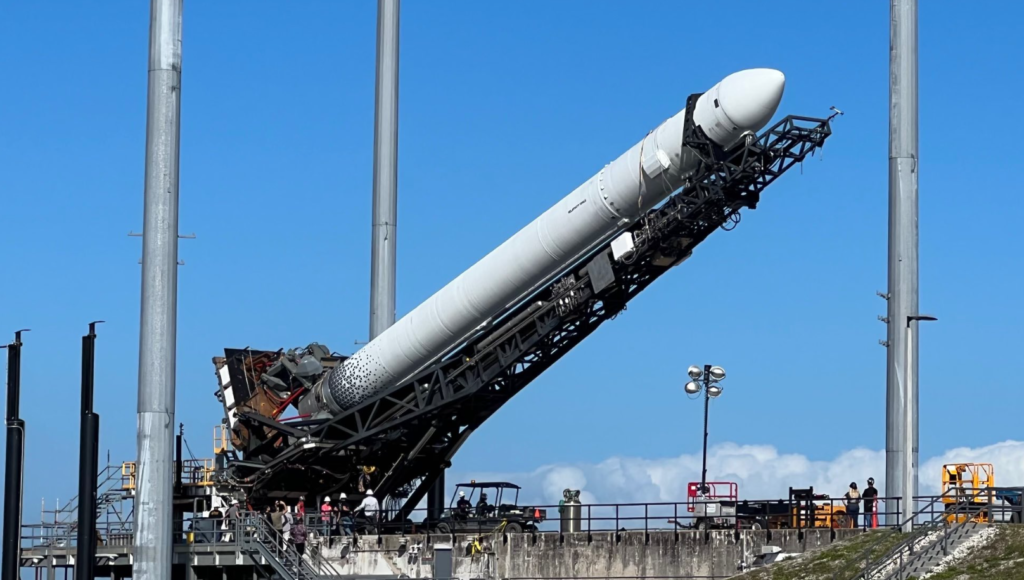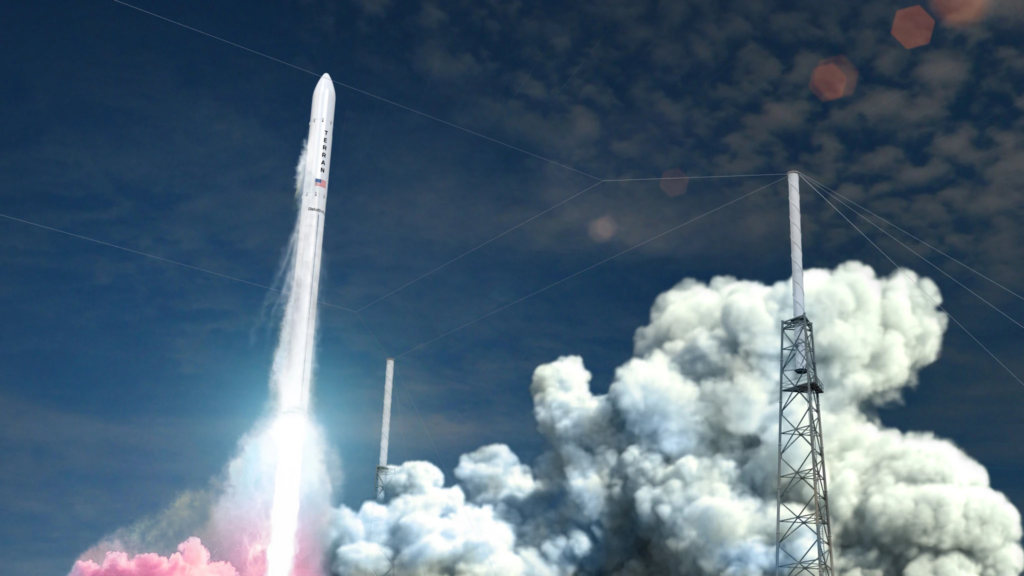
When Can We Expect Terran 1 To Lift Off For The First Time?
Relativity Space has been moving quickly in preparation for the first ever launch for the company and the Terran 1 rocket. This month alone we have watched the test article move to the pad, integrate, and go vertical. Once ready, the first 3D printed orbital rocket will attempt to lift off and mark a major milestone within the space industry and Relativity.
However, with all this progress being made, it brings up the question of when will this launch actually happen. Currently, Relativity still has this mission scheduled to lift off in 2022. Unfortunately, with only one week left, this is most likely not going to be the case. While vertical, a few final tests still need to be completed before it’s ready to launch.
Not to mention the fact that this is the company’s first attempt ever which makes it more likely they will run into a few complications prior to the actual test. All of which comes in addition to even more progress on Relativity’s 1 million plus square foot headquarters and other valuable infrastructure. Here I will go more in-depth into a realistic launch date for Terran 1, the progress that’s been made, what to expect in the future, and more.
Terran 1 Launch Date

After being transported to Relativity’s launch site in Cape Canaveral earlier this year, around the middle of November the stages were mated. Next on December 5th, the full stage was successfully integrated onto the vehicle transporter erector. The next day the first Terran 1 test article was rolled out and onto the launch pad. Finally, on December 7th, Terran 1 went vertical on the pad. Not long after Relativity tweeted saying, “Documenting #newhistory in the making at Launch Complex 16! With nearly every department across the company represented, teams at the Cape yesterday gathered to commemorate a momentous week as we step into the final phases of testing for Terran 1’s #GLHF flight. This was the most recent update from the company on the progress toward this maiden flight.
By now, both the first and second stages have completed a significant test campaign in the months prior in order to make sure they are ready for the mission. Now that Terran 1 is vertical on the pad, they still need to perform a successful wet dress rehearsal and static fire of the rocket. This will be the final test to ensure every aspect is ready for the first launch attempt. However, it’s important to point out that this process could go two ways. Here, if the testing goes exactly as planned and Relativity is ready, we could see a launch in just 2 or 3 weeks in early January of 2023. Even in this scenario the company only has a week to launch within 2022 which is very unlikely considering the decent amount of work that still needs to be completed.
The other way this could go would involve issues during a phase of the upcoming testing. Being that it’s Relativity’s first launch, the company is about to experience many firsts that will inevitably slow them down. If static fire test results for example end up not performing as expected, it will add a decent amount of time in delays in order to fix everything and ensure the best possible chances of success for the maiden flight. Not to mention, the following week is usually slow due to holidays and various celebrations. All of which practically guarantees that the launch won’t happen until at least early 2023.
Terran 1 Overview

Now that we know more about Terran 1’s first launch and when we can realistically expect it to happen, we can take a closer look at other related updates and important aspects of this launch such as the lack of a payload fairing. Only 3 days ago Tim Ellis tweeted mentioning, “It’s happening…” This included a short video from the air showcasing the word Relativity beginning to be painted on the side of a massive building. Soon after he clarified that “This is @relativityspace new 1,000,000+ square foot factory. Ramping production of hardware now. A lot to build out over time still but this is where we are making our new rocket Terran R.” This 93-acre former Boeing C-17 manufacturing plant in Long Beach, called “The Wormhole” is one of the largest headquarters in the private space industry. It features 100 ft. fall ceilings and a capacity for 2,000+ employees, metallurgical laboratory, powder bed fusion (PBF) printers, mission control center, as well as dozens of the company’s proprietary Stargate 3D printers, the largest metal 3D printers in the world. An exciting update that will have a big impact on both Terran 1 and Terran R’s future.
Focusing back on the upcoming mission, we can look at the rocket itself and some unique features specifically for this mission. For one, rather than a payload fairing, the Terran 1 test article only features a nosecone. Since this first mission doesn’t include any customer payloads, the company opted to go this route rather than full fairing. Normally, the payload fairing leads its class in volume at 3 m (10 ft) diameter x 6.8 m (22.2 ft) with a 986 mm (38.81 in) standard payload interface. Terran 1’s fairing volume accommodates a variety of payload designs and configurations, including dedicated launch for single payloads and constellations as well as multi-manifest and rideshare configurations.
In terms of the overall mission, called “GLHF” (Good Luck, Have Fun), the launch is set to happen from Launch Complex 16 (LC-16) in Cape Canaveral. As a two-stage, 110ft. tall, 7.5 ft. wide, expendable rocket, Terran 1 is the largest 3D printed object to exist and to attempt orbital flight. Working towards its goal of being 95% 3D printed, Relativity’s first Terran 1 vehicle is 85% 3D printed by mass. Terran 1 has nine Aeon engines on its first stage, and one Aeon Vac on its second stage. Like its structure, all Relativity engines are entirely 3D printed, and use liquid oxygen (LOX) and liquid natural gas (LNG), which are not only the best for rocket propulsion, but also for reusability, and the easiest to eventually transition to methane on Mars. As one of the few LOX/LNG fueled rockets in the industry, Terran 1 is racing to be the first LOX/LNG rocket to fly. Based on its current progress and possible launch date within only weeks, it could absolutely be the first to fly using this propellant combination.
At the bottom, the Terran 1 first stage assembly consists of three main components: the thrust structure, the Stage 1 tank, and the interstage. The tanks share a common dome and airframe that is integrally printed as monolithic sections, where a horizontal welding process integrates Stage 1 segments together to achieve the final stage structure. A transfer tube carries LOX through the center of the LNG tank to the engines. Nine Aeon-1 engines power the first stage with up to 23,000 lbf thrust per engine at sea level, for a total thrust of up to 207,000 lbf at liftoff. Terran 1 autogeneously pressurizes the tanks with gaseous natural gas and gaseous oxygen via heat exchangers integrated into the Aeon-1 engines, eliminating the need for a separate pressurization system and avoiding the use of helium on the vehicle entirely. Electromechanical actuators gimbal the outer 8 engines, providing thrust vector control. The stage separation system is located at the forward end of the interstage and interfaces with the second stage.
Moving up, the Terran 1 second stage consists of a monolithic printed tank with an integral common dome, payload attach fitting, and separable fairing. A single Aeon Vacuum engine powers the second stage with up to 28,300 lbf-vac using a fixed 165:1 expansion nozzle and is capable of multiple restarts including provisions for a deorbit burn. Similar to Stage 1, a heat exchanger on the AeonVac engine generates gaseous natural gas and gaseous oxygen that pressurize their respective tanks autogeneously. Stage 2’s payload controller offers separation initiation, separation detection, ethernet, and serial in-flight payload telemetry channels. Pitch and yaw control is provided by electro-mechanical thrust vector control actuators affixed to the Aeon Vacuum engine. Roll control and pointing are performed using cold nitrogen gas reaction control thrusters located near the aft end.
Going more in-depth into the propulsion aspect, Relativity’s Aeon engines are designed, assembled, and tested in house. Except for the second-stage nozzle extension, each of Terran 1’s 10 engines is based on a common design— enabling simplified and repeatable manufacturing and acceptance testing. Aeon engines are fueled by liquid natural gas and liquid oxygen and operate using the gas generator engine cycle. Each engine uses two turbopump assemblies for thrust and mixture ratio control: one for liquid natural gas and one for liquid oxygen. The thrust chamber is regeneratively cooled with liquid natural gas, which is then injected into the main combustion chamber and burned with liquid oxygen to produce the required thrust. While all of these systems have been tested very thoroughly by themselves, the big moment is just around the corner. Here we will see the first launch of all these systems combined into a unique rocket trying to change the manufacturing process within the industry.
Conclusion
Relativity Space is only a few weeks away from Terran 1’s first launch assuming they perform a static fire very soon and it provides promising results. However, being that it’s the company’s first ever launch and the first for Terran 1, a lot of things could delay it in the coming days. We will have to wait and see how it progresses and the impact it has on the space industry.

Hi! What was a material used for printing of combustion chamber and nozzle? Why the nozzle is so short and the chamber so high? (Compare with the shape of RD-114 or F-1.)